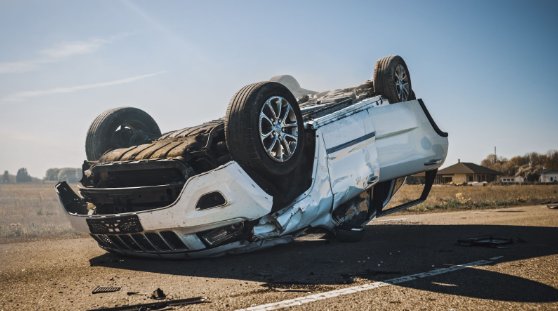Car rollovers are among the most severe vehicle accidents, where a car tips over onto its side or roof. These incidents can range from a single, dramatic roll to multiple chaotic turns before the vehicle comes to a stop. Often resulting in grave injuries, rollovers typically occur in single-car accidents, though they can involve multiple vehicles.
The Mechanics Behind Car Rollovers
Several factors contribute to the occurrence of car rollovers, with the following being the most prevalent:
-
Tripping
is a leading cause of rollovers. When a vehicle’s tire encounters an obstacle such as a curb or ditch, this interaction disrupts the vehicle’s balance, shifting its weight abruptly and causing it to roll.
-
Speeding
Driving too fast around curves or making high-speed turns can cause tires to lose their grip on the road, which might trigger a rollover. Additionally, the impact from another vehicle in a collision can have enough force to flip a car.
-
Inclement Weather
Slippery rain, snow, or ice conditions significantly increase the likelihood of losing control and rolling over.
-
Vehicles at Greater Risk
While any car can experience a rollover, certain types are more prone to it because of their design.With their higher centers of gravity, SUVs, trucks, and vans are particularly prone to tipping over. However, advancements in vehicle design and new safety technologies have made newer models of these vehicles less likely to experience rollovers.
The Role of Auto Insurance
Auto insurance plays a crucial role in addressing the financial implications in the aftermath of a rollover.If another driver is responsible for the accident, their liability insurance should take care of the damages and injuries, but only up to what their policy allows. On the other hand, for single-vehicle rollovers, which constitute the majority of these accidents, having collision coverage is crucial for covering the car’s damages. Without this type of insurance, you’ll be responsible for the repair costs yourself.
Strategies to Avoid Rollovers
The following preventative measures can markedly reduce the chances of experiencing such an accident:
Choosing Safe Vehicles
When shopping for a new car, it’s essential to focus on selecting models that come with the most current and sophisticated safety technologies on offer.Among these features, electronic stability control stands out as particularly effective in mitigating the risk of rollovers. This technology helps maintain control during extreme maneuvers by automatically applying brakes to individual wheels, thereby preventing loss of traction that could lead to a rollover. Therefore, dedicating time to research and choose vehicles that incorporate such innovative safety mechanisms can play a significant role in ensuring your and your passengers’ safety on the road.
Tire Maintenance
Ensuring your tires are properly inflated, balanced, and have adequate tread is essential for maintaining stability and grip on the road.
Load Management
Overloading your vehicle can compromise its stability. Adhering to the manufacturer’s recommended load limits and avoiding heavy roof storage can help maintain a lower center of gravity.
Speed Management
Observing speed limits and adjusting speed according to road conditions are vital for maintaining vehicle control.
Focused Driving
Distractions are a major cause of accidents. Keeping your attention on the road and avoiding phone use while driving can prevent unexpected incidents.
Conclusion
Car rollovers are rarer but more dangerous than many other types of car accidents, often leading to serious injuries or even death. Knowing what causes rollovers, like going too fast, hitting something that makes the car tip, or the kind of car you have, can help you avoid them.
Driving newer cars with safety features carefully can also lower the chance of a rollover. Having the right insurance can help cover costs if an accident happens. Being aware and careful can keep you and your passengers safe from rollover accidents.
FAQs
What are the first steps I should take immediately after experiencing a car rollover?
Ensure the safety of all passengers by checking for injuries and calling emergency services for medical help if needed. Turn off the engine if possible, and do not exit the vehicle until it’s safe to do so. Once safe, document the scene with photos and notes for insurance purposes.
How can I tell if a vehicle has good rollover resistance before I buy it?
Look for the vehicle’s rollover rating provided by safety organizations such as the National Highway Traffic Safety Administration (NHTSA). Higher ratings indicate better rollover resistance. Additionally, research the vehicle’s design features, like electronic stability control, that aid in preventing rollovers.
What does electronic stability control (ESC) do to prevent rollovers?
ESC detects and reduces loss of traction (skidding), preventing the under or oversteering that can lead to a rollover. It automatically applies the brakes to individual wheels and can reduce engine power to help the driver maintain control of the vehicle.
How often should I check my tires to reduce the risk of a rollover?
Check your tire pressure at least once a month and before long trips. Also, inspect tires regularly for wear and tear, and replace them as needed to ensure optimal performance and safety.
Get the right coverage for your car with tutenagency
New tutenagency customers?
Quote auto insurance online or call (334) 502-5111 to insure your vehicle.
Legal Disclaimer: ADVERTISING MATERIAL ONLY. Do not rely on this site or this article for legal or financial advice. The information provided on 210agency.com is strictly for educational purposes and to provide you with general educational information. Since state laws and financial regulations are subject to change, please schedule an appointment with an attorney or qualified financial advisor in your area to further discuss your personal situation. This public information is neither intended to, nor will it, create an attorney-client or financial representative relationship.

